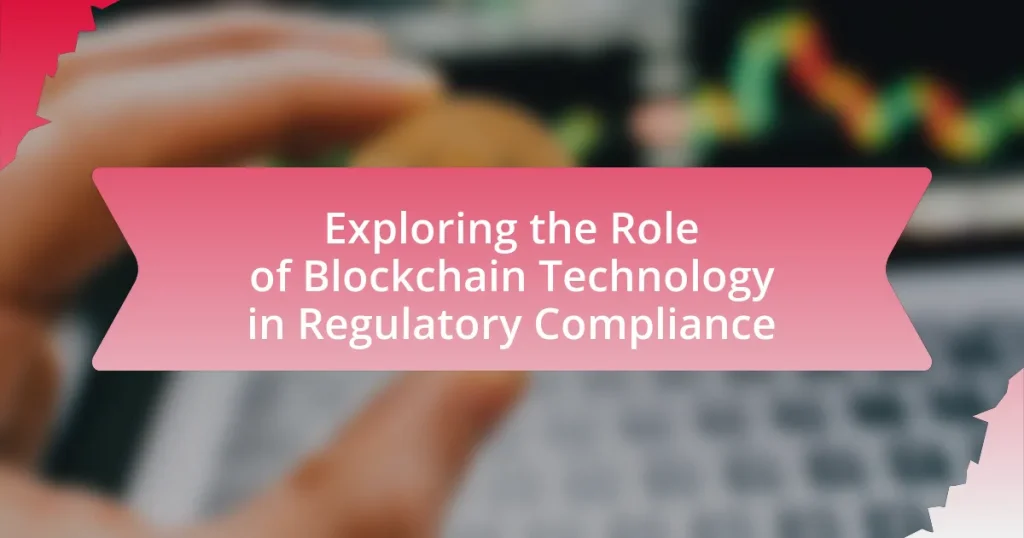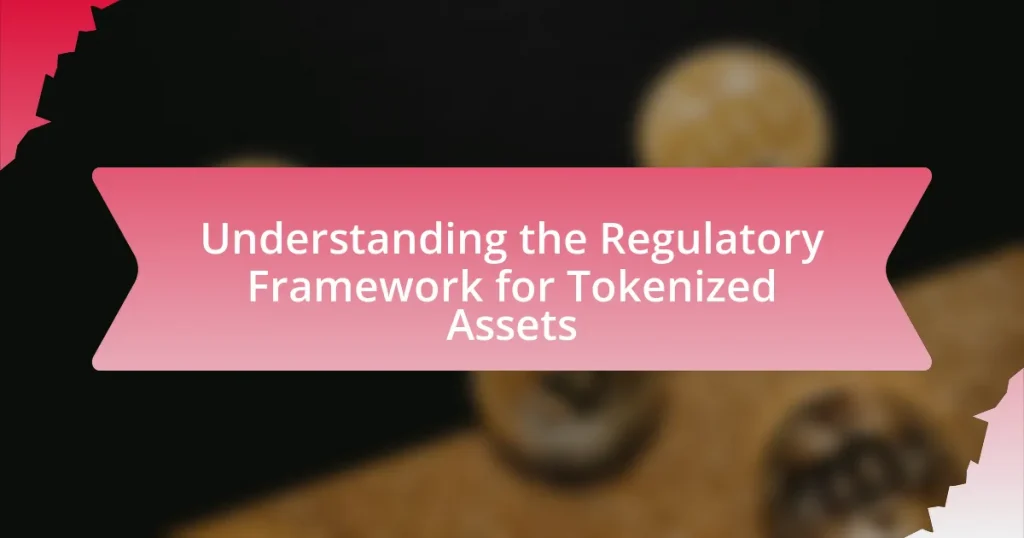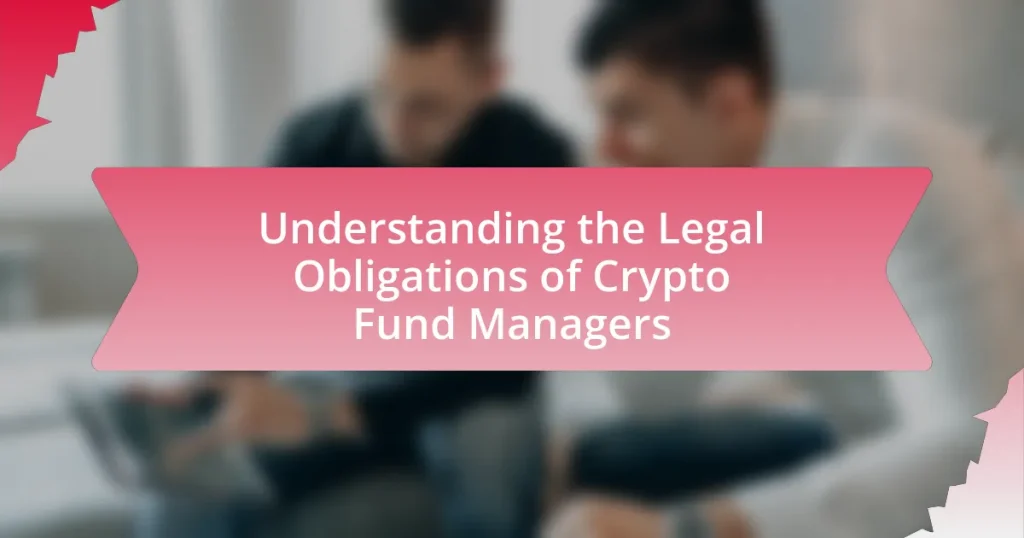Blockchain technology significantly enhances regulatory compliance by providing a transparent, immutable, and decentralized ledger that facilitates real-time tracking and auditing of transactions. Key features such as transparency, traceability, and security improve data management, reduce compliance costs, and foster trust among stakeholders. The article explores how blockchain is implemented across various industries, including finance and healthcare, to streamline compliance processes, automate reporting, and ensure adherence to regulations like anti-money laundering (AML) and know your customer (KYC). Additionally, it addresses the challenges organizations face in regulatory compliance, the limitations of traditional methods, and the future trends shaping the regulatory landscape in relation to blockchain technology.
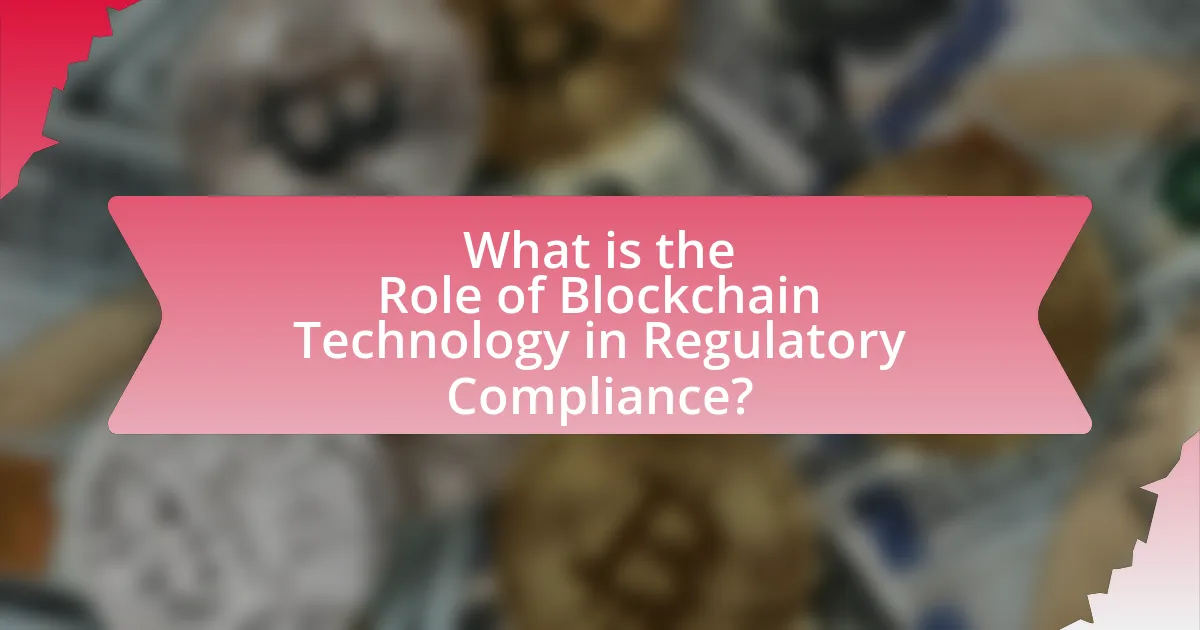
What is the Role of Blockchain Technology in Regulatory Compliance?
Blockchain technology plays a crucial role in regulatory compliance by enhancing transparency, traceability, and security in data management. Its decentralized nature allows for immutable record-keeping, which ensures that all transactions are permanently recorded and can be audited in real-time. For instance, in the financial sector, blockchain can streamline compliance processes by providing regulators with immediate access to transaction data, thereby reducing the risk of fraud and ensuring adherence to anti-money laundering (AML) and know your customer (KYC) regulations. According to a report by the World Economic Forum, blockchain can reduce compliance costs by up to 30% by automating reporting and verification processes. This capability not only improves efficiency but also fosters trust among stakeholders, as all parties can independently verify the integrity of the data.
How does blockchain technology enhance regulatory compliance?
Blockchain technology enhances regulatory compliance by providing a transparent, immutable, and decentralized ledger that facilitates real-time tracking and auditing of transactions. This transparency allows regulators to access accurate and up-to-date information, reducing the risk of fraud and ensuring adherence to compliance standards. For instance, in the financial sector, blockchain can automate compliance processes through smart contracts, which execute predefined rules automatically, thereby minimizing human error and increasing efficiency. Additionally, the use of blockchain can streamline reporting requirements, as data recorded on the blockchain is easily verifiable and traceable, which supports regulatory audits and investigations.
What are the key features of blockchain that support compliance?
The key features of blockchain that support compliance include transparency, immutability, and traceability. Transparency allows all participants in a blockchain network to access the same information, ensuring that data is visible and verifiable, which is crucial for regulatory oversight. Immutability ensures that once data is recorded on the blockchain, it cannot be altered or deleted, providing a reliable audit trail that meets compliance requirements. Traceability enables the tracking of transactions and changes over time, facilitating the monitoring of compliance with regulations. These features collectively enhance accountability and trust in the data, which is essential for meeting regulatory standards.
How does transparency in blockchain affect regulatory oversight?
Transparency in blockchain enhances regulatory oversight by providing real-time access to transaction data, which facilitates monitoring and compliance verification. This visibility allows regulators to track financial activities and identify suspicious behavior more effectively, thereby reducing fraud and increasing accountability. For instance, the Financial Action Task Force (FATF) emphasizes that blockchain’s immutable ledger can aid in anti-money laundering (AML) efforts by ensuring that all transactions are traceable and verifiable. Consequently, the inherent transparency of blockchain technology supports regulators in enforcing laws and regulations more efficiently.
Why is regulatory compliance important for businesses?
Regulatory compliance is important for businesses because it ensures adherence to laws and regulations, which helps avoid legal penalties and enhances operational integrity. Compliance protects businesses from fines, lawsuits, and reputational damage, as evidenced by a 2020 study by the Ponemon Institute, which found that organizations with strong compliance programs experienced 50% fewer data breaches than those without. Furthermore, regulatory compliance fosters trust among customers and stakeholders, as it demonstrates a commitment to ethical practices and accountability.
What are the consequences of non-compliance?
Non-compliance with regulatory standards can lead to significant legal and financial repercussions for organizations. These consequences often include hefty fines, which can range from thousands to millions of dollars depending on the severity of the violation, as evidenced by the U.S. Securities and Exchange Commission imposing over $4 billion in penalties in 2020 alone. Additionally, non-compliance can result in reputational damage, loss of customer trust, and potential criminal charges against executives, as seen in high-profile cases like Enron and Volkswagen. Furthermore, organizations may face operational disruptions and increased scrutiny from regulators, which can hinder business growth and innovation.
How can compliance improve business reputation and trust?
Compliance enhances business reputation and trust by demonstrating adherence to laws and regulations, which fosters credibility among stakeholders. When a business consistently meets compliance standards, it signals reliability and ethical practices, leading to increased customer confidence and loyalty. For instance, a study by the Ponemon Institute found that organizations with strong compliance programs experience 30% fewer data breaches, which directly correlates with improved public perception and trust. Additionally, compliance can mitigate risks and reduce the likelihood of legal penalties, further solidifying a company’s reputation as a responsible entity in its industry.
What challenges do organizations face in regulatory compliance?
Organizations face several challenges in regulatory compliance, including the complexity of regulations, the cost of compliance, and the need for continuous monitoring. The complexity arises from the diverse and often changing regulatory landscape, which can vary significantly across jurisdictions and industries. This complexity requires organizations to invest in specialized knowledge and resources to interpret and implement regulations effectively.
The cost of compliance can be substantial, as organizations must allocate financial and human resources to ensure adherence to regulations, which can strain budgets, especially for smaller entities. Continuous monitoring is essential to remain compliant, as regulations can change frequently, necessitating ongoing updates to policies and procedures.
According to a survey by the Regulatory Compliance Association, 60% of organizations reported that keeping up with regulatory changes is their biggest challenge, highlighting the significant burden compliance places on businesses.
How do traditional compliance methods fall short?
Traditional compliance methods fall short due to their reliance on manual processes, which are often time-consuming and prone to human error. These methods typically involve extensive paperwork and fragmented systems that hinder real-time data access and analysis. For instance, a study by the Association of Certified Fraud Examiners found that organizations using manual compliance processes experience a 30% higher rate of compliance failures compared to those employing automated solutions. Additionally, traditional methods struggle to adapt to rapidly changing regulations, leading to increased risks of non-compliance and potential penalties.
What are the risks associated with non-compliance?
Non-compliance poses significant risks, including legal penalties, financial losses, and reputational damage. Organizations that fail to adhere to regulations may face fines that can reach millions of dollars, as evidenced by the $5 billion fine imposed on Facebook in 2019 for privacy violations. Additionally, non-compliance can lead to operational disruptions, as companies may be forced to halt business activities until they rectify compliance issues. The long-term impact includes loss of customer trust and market share, as seen in cases like Equifax, which suffered a data breach and subsequent loss of consumer confidence due to non-compliance with data protection regulations.
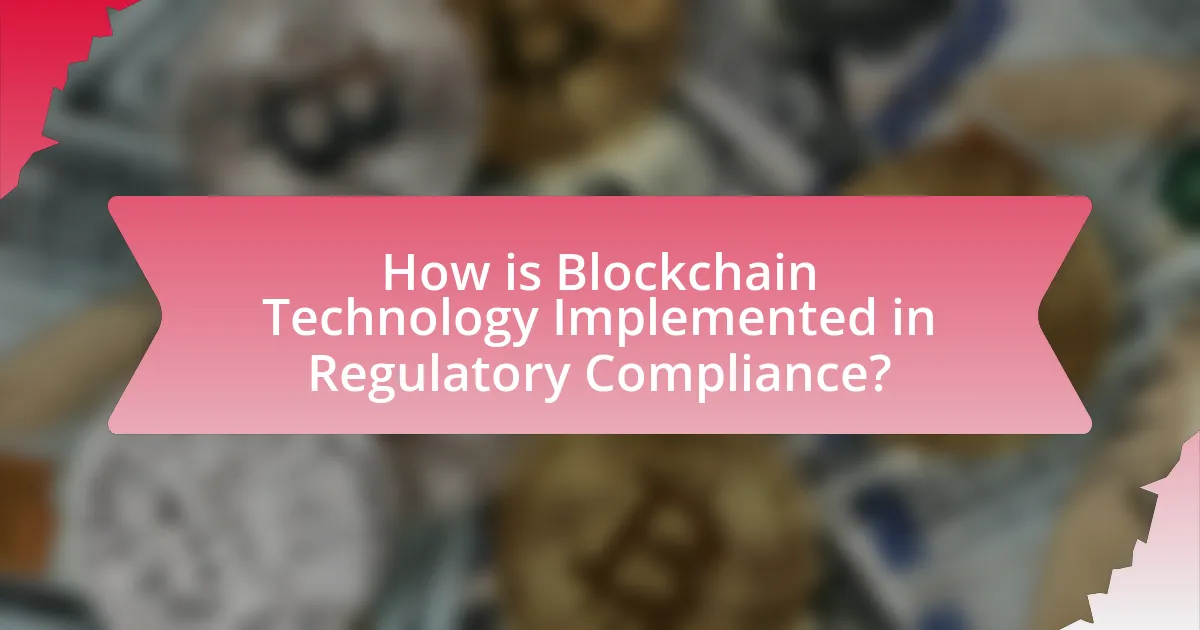
How is Blockchain Technology Implemented in Regulatory Compliance?
Blockchain technology is implemented in regulatory compliance through the creation of transparent, immutable records that facilitate real-time monitoring and auditing of transactions. This technology enables organizations to maintain a secure and tamper-proof ledger, which can be accessed by regulators to ensure adherence to laws and regulations. For instance, in the financial sector, blockchain can streamline Know Your Customer (KYC) processes by allowing multiple institutions to share verified customer data without compromising privacy. Additionally, the use of smart contracts automates compliance checks, reducing the risk of human error and enhancing efficiency. According to a report by the World Economic Forum, blockchain can significantly reduce compliance costs and improve the accuracy of regulatory reporting, demonstrating its effectiveness in this domain.
What are the steps for integrating blockchain into compliance processes?
The steps for integrating blockchain into compliance processes include assessing regulatory requirements, selecting the appropriate blockchain platform, designing the compliance framework, implementing smart contracts, conducting pilot testing, and ensuring ongoing monitoring and auditing.
First, organizations must assess regulatory requirements to understand the specific compliance obligations they need to meet. Next, selecting the appropriate blockchain platform is crucial, as different platforms offer varying features and capabilities that can impact compliance. After that, designing the compliance framework involves outlining how blockchain will be utilized to meet regulatory standards.
Implementing smart contracts automates compliance processes, ensuring that transactions adhere to regulations without manual intervention. Conducting pilot testing allows organizations to evaluate the effectiveness of the blockchain solution in real-world scenarios. Finally, ensuring ongoing monitoring and auditing is essential to maintain compliance and adapt to any regulatory changes.
These steps are supported by industry reports indicating that organizations leveraging blockchain for compliance can enhance transparency and reduce the risk of non-compliance.
How do organizations assess their readiness for blockchain adoption?
Organizations assess their readiness for blockchain adoption by evaluating their existing infrastructure, skills, and regulatory compliance requirements. This assessment typically involves conducting a gap analysis to identify the current state of technology and processes compared to the desired state that blockchain can facilitate. Additionally, organizations often perform a risk assessment to understand potential challenges and regulatory implications associated with blockchain implementation. According to a Deloitte survey, 40% of organizations cited regulatory compliance as a significant factor influencing their blockchain readiness, highlighting the importance of aligning blockchain initiatives with existing legal frameworks.
What are the best practices for implementing blockchain solutions?
The best practices for implementing blockchain solutions include conducting a thorough needs assessment, selecting the appropriate blockchain platform, ensuring regulatory compliance, and prioritizing security measures. A needs assessment helps identify specific use cases and requirements, which guides the selection of a suitable blockchain platform, such as Ethereum or Hyperledger, based on scalability and functionality. Regulatory compliance is crucial, as organizations must adhere to laws and regulations relevant to their industry, such as GDPR for data protection. Additionally, implementing robust security measures, including encryption and access controls, protects sensitive data and maintains the integrity of the blockchain. These practices are supported by industry reports, such as the “Blockchain Technology: A Guide for Legal and Compliance Professionals” by the International Association for Privacy Professionals, which emphasizes the importance of compliance and security in blockchain implementations.
What industries are leveraging blockchain for compliance?
Various industries are leveraging blockchain for compliance, including finance, healthcare, supply chain management, and energy. In finance, blockchain enhances transparency and traceability, aiding in anti-money laundering (AML) and know your customer (KYC) regulations. The healthcare sector utilizes blockchain to secure patient data and ensure compliance with regulations like HIPAA. Supply chain management benefits from blockchain by providing immutable records that help in tracking product origins and ensuring adherence to safety standards. The energy industry employs blockchain for tracking renewable energy credits and ensuring compliance with environmental regulations. These applications demonstrate how blockchain technology is effectively addressing compliance challenges across multiple sectors.
How is blockchain used in the financial sector for compliance?
Blockchain is used in the financial sector for compliance by providing a transparent and immutable ledger that enhances regulatory reporting and audit processes. Financial institutions utilize blockchain to ensure accurate record-keeping, which facilitates real-time monitoring of transactions and compliance with regulations such as Anti-Money Laundering (AML) and Know Your Customer (KYC) requirements. For instance, the integration of blockchain technology allows for the automatic verification of customer identities and transaction histories, reducing the risk of fraud and ensuring adherence to regulatory standards. Additionally, the decentralized nature of blockchain minimizes the potential for data tampering, thereby increasing trust among stakeholders and regulators.
What role does blockchain play in healthcare regulatory compliance?
Blockchain enhances healthcare regulatory compliance by providing a secure, transparent, and immutable ledger for storing patient data and transaction records. This technology ensures that all data entries are time-stamped and cannot be altered, which is crucial for maintaining the integrity of health records and meeting regulatory standards such as HIPAA. For instance, a study published in the Journal of Medical Internet Research highlights that blockchain can streamline compliance processes by automating audits and ensuring data provenance, thereby reducing the risk of data breaches and ensuring accountability in healthcare practices.
What are the potential drawbacks of using blockchain for compliance?
The potential drawbacks of using blockchain for compliance include scalability issues, regulatory uncertainty, and data privacy concerns. Scalability challenges arise because many blockchain networks struggle to handle a high volume of transactions efficiently, which can hinder compliance processes that require rapid data processing. Regulatory uncertainty exists as the legal status of blockchain technology varies across jurisdictions, complicating compliance efforts for organizations operating in multiple regions. Additionally, data privacy concerns emerge since blockchain’s inherent transparency can conflict with regulations like GDPR, which mandates the right to erasure and data minimization. These drawbacks highlight the complexities organizations face when integrating blockchain into their compliance frameworks.
What are the limitations of blockchain technology in regulatory contexts?
Blockchain technology faces several limitations in regulatory contexts, primarily due to its inherent characteristics such as immutability, decentralization, and pseudonymity. These features can complicate compliance with existing regulations that require transparency, accountability, and the ability to reverse transactions. For instance, the immutability of blockchain records makes it difficult to amend or delete erroneous data, which can conflict with regulations that mandate data correction. Additionally, the decentralized nature of blockchain can hinder the identification of responsible parties, complicating enforcement actions and regulatory oversight. Furthermore, the pseudonymous aspect of transactions poses challenges for anti-money laundering (AML) and know-your-customer (KYC) regulations, as it can obscure the identities of users involved in transactions. These limitations highlight the need for regulatory frameworks that can adapt to the unique properties of blockchain technology while ensuring compliance with legal standards.
How can organizations mitigate risks associated with blockchain implementation?
Organizations can mitigate risks associated with blockchain implementation by conducting thorough risk assessments and ensuring compliance with regulatory frameworks. By identifying potential vulnerabilities, such as security threats and legal uncertainties, organizations can develop strategies to address these risks proactively. For instance, implementing robust cybersecurity measures, such as encryption and multi-signature protocols, can protect against unauthorized access and data breaches. Additionally, staying informed about evolving regulations, such as the General Data Protection Regulation (GDPR) in Europe, allows organizations to align their blockchain practices with legal requirements, thereby reducing the risk of non-compliance penalties.

What Future Trends Can We Expect in Blockchain and Regulatory Compliance?
Future trends in blockchain and regulatory compliance include increased integration of smart contracts, enhanced transparency through decentralized ledgers, and the development of regulatory frameworks tailored for blockchain technology. Smart contracts automate compliance processes, reducing human error and increasing efficiency, as evidenced by their use in sectors like finance and supply chain management. Decentralized ledgers provide real-time access to transaction data, fostering trust and accountability among stakeholders, which is crucial for industries facing stringent regulatory scrutiny. Additionally, regulatory bodies are beginning to establish guidelines that specifically address blockchain applications, as seen in jurisdictions like the European Union, which is working on the Markets in Crypto-Assets Regulation (MiCA) to create a comprehensive regulatory framework. These trends indicate a shift towards a more structured and compliant blockchain ecosystem.
How is the regulatory landscape evolving with blockchain technology?
The regulatory landscape is evolving with blockchain technology through increased government scrutiny and the establishment of clearer guidelines. Governments worldwide are recognizing the potential of blockchain for enhancing transparency and efficiency in regulatory compliance, leading to initiatives such as the European Union’s Markets in Crypto-Assets (MiCA) regulation, which aims to create a comprehensive framework for digital assets. Additionally, the Financial Action Task Force (FATF) has issued guidelines for the regulation of virtual assets, emphasizing the need for anti-money laundering (AML) measures. These developments indicate a shift towards more structured oversight, balancing innovation with consumer protection and financial stability.
What upcoming regulations may impact blockchain use in compliance?
Upcoming regulations that may impact blockchain use in compliance include the European Union’s Markets in Crypto-Assets (MiCA) regulation, which aims to create a comprehensive framework for digital assets and enhance consumer protection. This regulation is expected to enforce stricter compliance requirements for blockchain-based financial services, including transparency and reporting obligations. Additionally, the Financial Action Task Force (FATF) is pushing for global standards on anti-money laundering (AML) and counter-terrorism financing (CTF) that will require blockchain platforms to implement robust Know Your Customer (KYC) processes. These regulatory developments are significant as they will shape how blockchain technology is utilized in compliance frameworks across various jurisdictions.
How are governments and organizations adapting to blockchain innovations?
Governments and organizations are adapting to blockchain innovations by implementing regulatory frameworks that facilitate the integration of blockchain technology into existing systems. For instance, countries like Switzerland and Singapore have established clear guidelines for Initial Coin Offerings (ICOs) and cryptocurrency exchanges, promoting innovation while ensuring consumer protection and financial stability. Additionally, organizations are leveraging blockchain for enhanced transparency and traceability in supply chains, as seen in initiatives by companies like IBM and Walmart, which utilize blockchain to track food products from farm to table, thereby improving safety and compliance with health regulations. These adaptations demonstrate a proactive approach to harnessing blockchain’s potential while addressing regulatory challenges.
What innovations in blockchain could further enhance compliance?
Innovations in blockchain that could further enhance compliance include the implementation of smart contracts, zero-knowledge proofs, and decentralized identity solutions. Smart contracts automate compliance processes by executing predefined rules, reducing human error and increasing efficiency. For instance, they can automatically enforce regulatory requirements in real-time, ensuring that transactions comply with legal standards without manual intervention. Zero-knowledge proofs enhance privacy while allowing verification of compliance without revealing sensitive information, which is crucial for industries like finance and healthcare. Decentralized identity solutions provide individuals and organizations with control over their data, enabling secure and compliant identity verification processes. These innovations collectively improve transparency, reduce fraud, and streamline regulatory adherence, making compliance more efficient and reliable.
How might smart contracts revolutionize compliance processes?
Smart contracts can revolutionize compliance processes by automating and enforcing regulatory requirements through self-executing code on blockchain platforms. This automation reduces human error and increases efficiency, as smart contracts can automatically verify compliance with regulations in real-time without the need for intermediaries. For instance, a study by the World Economic Forum highlights that smart contracts can streamline processes in industries like finance and supply chain by ensuring that all parties adhere to agreed-upon terms, thus enhancing transparency and accountability. Additionally, the immutable nature of blockchain records provides a reliable audit trail, making it easier for organizations to demonstrate compliance during regulatory reviews.
What role does artificial intelligence play in blockchain compliance solutions?
Artificial intelligence enhances blockchain compliance solutions by automating the monitoring and analysis of transactions to ensure adherence to regulatory standards. AI algorithms can analyze vast amounts of data in real-time, identifying patterns and anomalies that may indicate non-compliance or fraudulent activities. For instance, a study by the International Journal of Information Management highlights that AI-driven tools can reduce compliance costs by up to 30% while improving accuracy in detecting suspicious transactions. This integration of AI not only streamlines compliance processes but also increases the overall security and integrity of blockchain systems.
What are the best practices for organizations adopting blockchain for compliance?
Organizations adopting blockchain for compliance should implement a comprehensive strategy that includes regulatory alignment, data integrity, and stakeholder engagement. Regulatory alignment ensures that blockchain applications meet existing laws and regulations, which is critical for avoiding legal pitfalls. Data integrity is maintained through cryptographic techniques that secure transaction records, providing an immutable audit trail that regulators can trust. Stakeholder engagement involves collaborating with regulators, industry peers, and technology providers to ensure that the blockchain solution is effective and compliant with evolving standards. These practices are supported by case studies showing that organizations that prioritize regulatory compliance in their blockchain initiatives experience fewer legal challenges and greater operational efficiency.
How can organizations ensure data integrity and security in blockchain systems?
Organizations can ensure data integrity and security in blockchain systems by implementing robust cryptographic techniques and consensus mechanisms. Cryptography secures data through hashing and encryption, ensuring that any alteration of data is easily detectable. For instance, the use of SHA-256 hashing in Bitcoin creates a unique digital fingerprint for each block, making tampering evident. Additionally, consensus mechanisms like Proof of Work or Proof of Stake validate transactions across the network, preventing unauthorized changes. These methods collectively enhance trust and reliability in blockchain systems, as evidenced by the increasing adoption of blockchain in sectors requiring stringent regulatory compliance, such as finance and healthcare.
What strategies can organizations use to stay compliant while using blockchain?
Organizations can stay compliant while using blockchain by implementing robust governance frameworks, conducting regular audits, and ensuring data privacy. A governance framework establishes clear policies and procedures that align blockchain operations with regulatory requirements, such as the General Data Protection Regulation (GDPR) in Europe. Regular audits help organizations assess compliance with these policies and identify potential risks, thereby maintaining accountability. Additionally, ensuring data privacy through encryption and access controls protects sensitive information, which is crucial for compliance with regulations like the Health Insurance Portability and Accountability Act (HIPAA) in the United States. These strategies collectively enhance an organization’s ability to navigate the complex regulatory landscape associated with blockchain technology.










